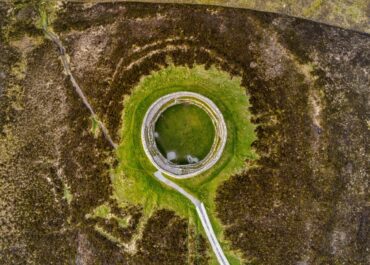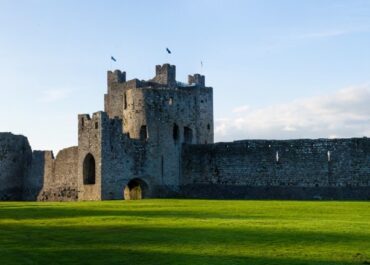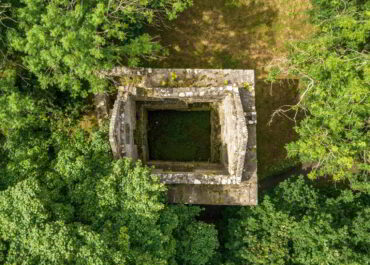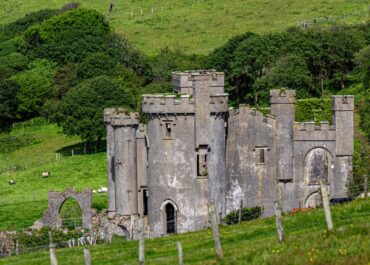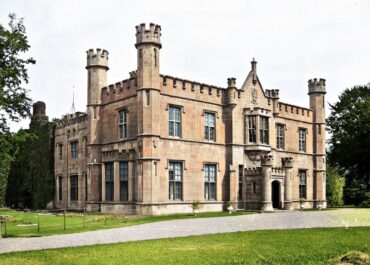Round Tower at Duleek (Commons), Co. Meath
Ireland's most architecturally devoured round tower survives as a haunting concave hollow within a medieval church wall; a ghostly void that preserves the exact interior dimensions of St. Cianán's lightning-struck tower from 1147, swallowed whole by Gothic builders who refused to destroy what they could not replace.
Round Tower at Duleek (Commons), Co. Meath
This remarkable site at Duleek represents one of Ireland’s most unusual round tower survivals; a structure that has been completely integrated into a later medieval church tower, leaving only a distinctive concave hollow as evidence of its original circular form. The tower’s extraordinary transformation provides unique insights into medieval architectural adaptation and the practical reuse of ancient Irish monuments.
The Lightning Strike of 1147
The round tower’s history is dramatically documented in medieval annals, which record that in 1147 “the cloigteach or round tower at St. Cianáin’s church was struck by lightning.” This specific dating provides rare documentation of a natural disaster affecting an Irish round tower and establishes that the structure was active and significant enough to warrant recording in contemporary chronicles.
The fact that the tower “survived into the high middle ages” after this lightning strike indicates either that the damage was repairable or that the structure was sufficiently robust to continue functioning despite whatever destruction the lightning may have caused.
Extraordinary Architectural Integration
What makes Duleek’s round tower absolutely unique is its complete incorporation into the west end of the parish church tower. Rather than standing as a separate structure, the ancient round tower was built into and around by later medieval church construction, creating an architectural hybrid found nowhere else in Ireland.
The surviving evidence appears as “a concave hollow (C 3.5m; H 14.3m) that tapers as it rises on the N side of the tower at the W end of the parish church.” This concave impression precisely preserves the negative space that would have been occupied by the circular interior of the original round tower, creating a remarkable archaeological record in reverse; instead of having the tower structure itself, we have the void it once filled.
Architectural Evidence of Integration
The tapering of the hollow as it rises follows the typical profile of Irish round tower interiors, which narrow gradually from base to summit. The preservation of this precise dimensioning within the later church tower construction demonstrates that the medieval builders worked carefully around the existing round tower, potentially using it as an architectural form or even constructing around a still-standing structure.
Innovative Access System
“At the top a pointed doorway leads to the second floor of the church tower,” revealing how the medieval builders created an integrated circulation system that connected the ancient round tower space with the new church tower. This pointed doorway represents Gothic architectural style typical of later medieval church construction, contrasting with the Romanesque or earlier traditions associated with round tower building.
This access arrangement suggests the hollow space retained functional importance within the later church complex, possibly serving as storage, access route, or even maintaining some ceremonial significance related to its ancient origins.
Architectural Dating and Historical Context
The pointed doorway and the style of integration suggest this remarkable adaptation took place during the Gothic period of Irish church architecture, likely in the 13th-15th centuries. This timing would place the integration several centuries after the 1147 lightning strike, indicating the round tower continued to be valued and maintained throughout the intervening period.
Saint Cianán and Ecclesiastical Continuity
The association with St. Cianán (also spelled Cianáin) emphasizes the site’s importance in early Irish Christianity. The preservation and integration of the round tower rather than its demolition suggests continued reverence for the ancient foundation and recognition of the tower’s significance within the ongoing ecclesiastical tradition.
Unique Archaeological Significance
Duleek’s round tower represents a completely unique survival type among Irish round towers. While other towers have been incorporated into later buildings (such as at Kilmallock), nowhere else has the integration been so complete that only the interior void remains as evidence of the original structure. This preservation method provides extraordinary evidence about round tower internal dimensions and construction techniques.
Evidence of Medieval Attitudes
The careful preservation and integration of the round tower at Duleek reveals important information about medieval Irish attitudes toward ancient monuments. Rather than viewing the old round tower as an obstacle to new construction, the medieval builders treated it as a valuable element worth incorporating into their architectural vision.
Conservation Through Integration
Paradoxically, the complete encasement of the round tower within the later church structure may have provided superior preservation compared to towers that remained freestanding and exposed to weather, structural failure, and human interference. The integration created a protected environment that has preserved precise dimensional evidence for over 800 years.
Good to Know
Location: Duleek (Commons), County Meath (integrated into west end of parish church)
Status: Integrated into later medieval church tower
Documented history: 1147 AD lightning strike (survived)
Survival type: Concave hollow preserving original interior void
Dimensions: C 3.5m circumference, H 14.3m height (tapering upward)
Associated saint: St. Cianán (Cianáin)
Integration features: Pointed doorway access to second floor of church tower
Historical significance: Unique example of complete round tower architectural integration
Archaeological value: Preserves precise interior dimensional evidence
Tags
Visitor Notes
Added by
IrishHistory.com
Lennox Barrow, G. 1979 The round towers of Ireland: a study and gazetteer. Dublin. The Academy Press.
Leask, H.G. 1960 (Reprint 1971, 1978 and 1985) Irish churches and monastic buildings, vol. III. Medieval gothic the last phases. Dundalk. Dundalgan Press.

